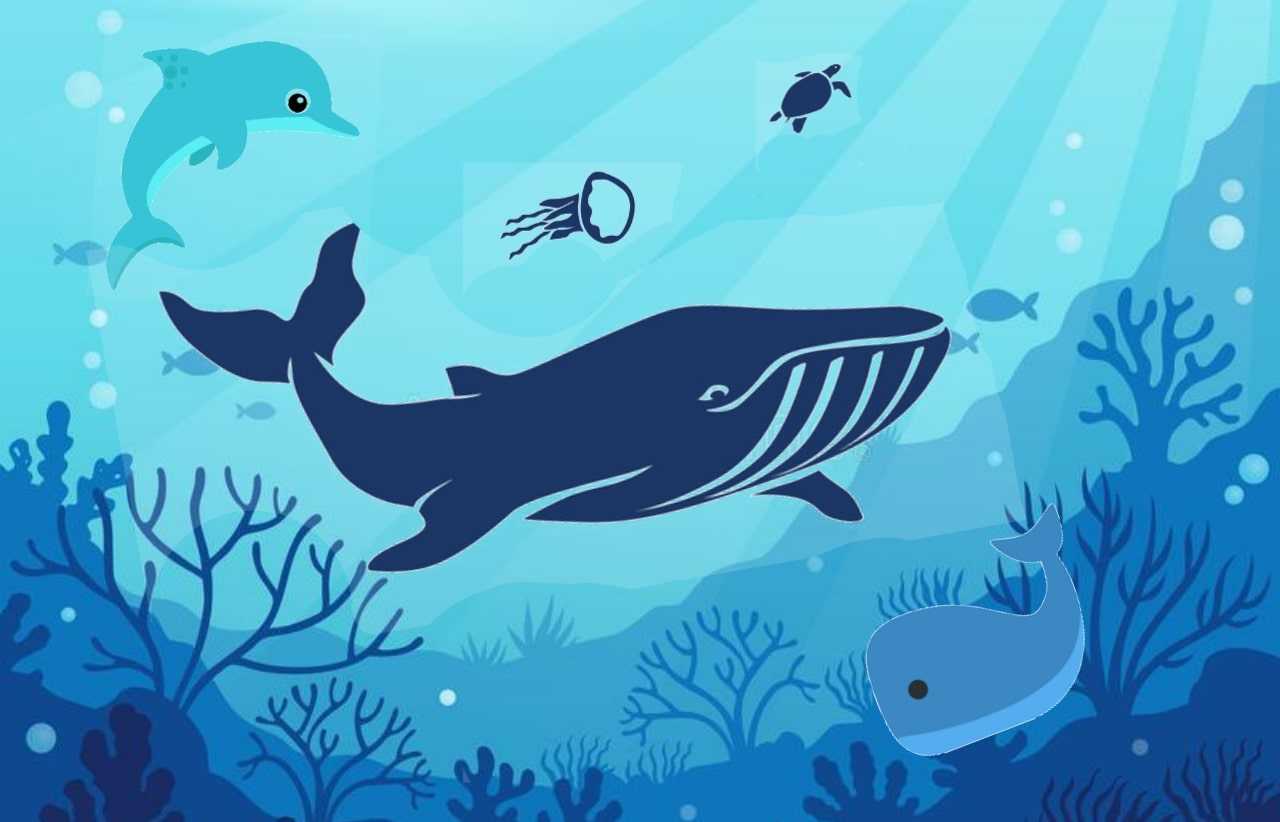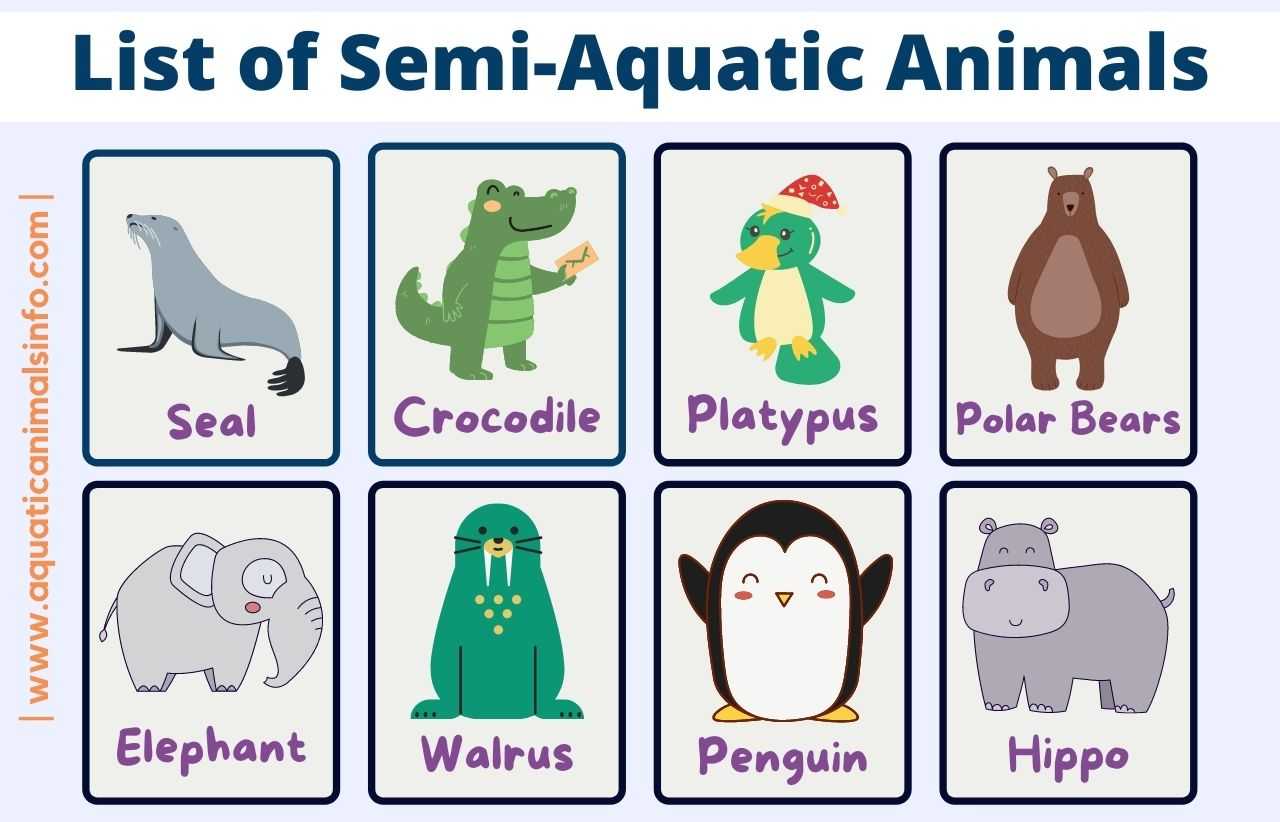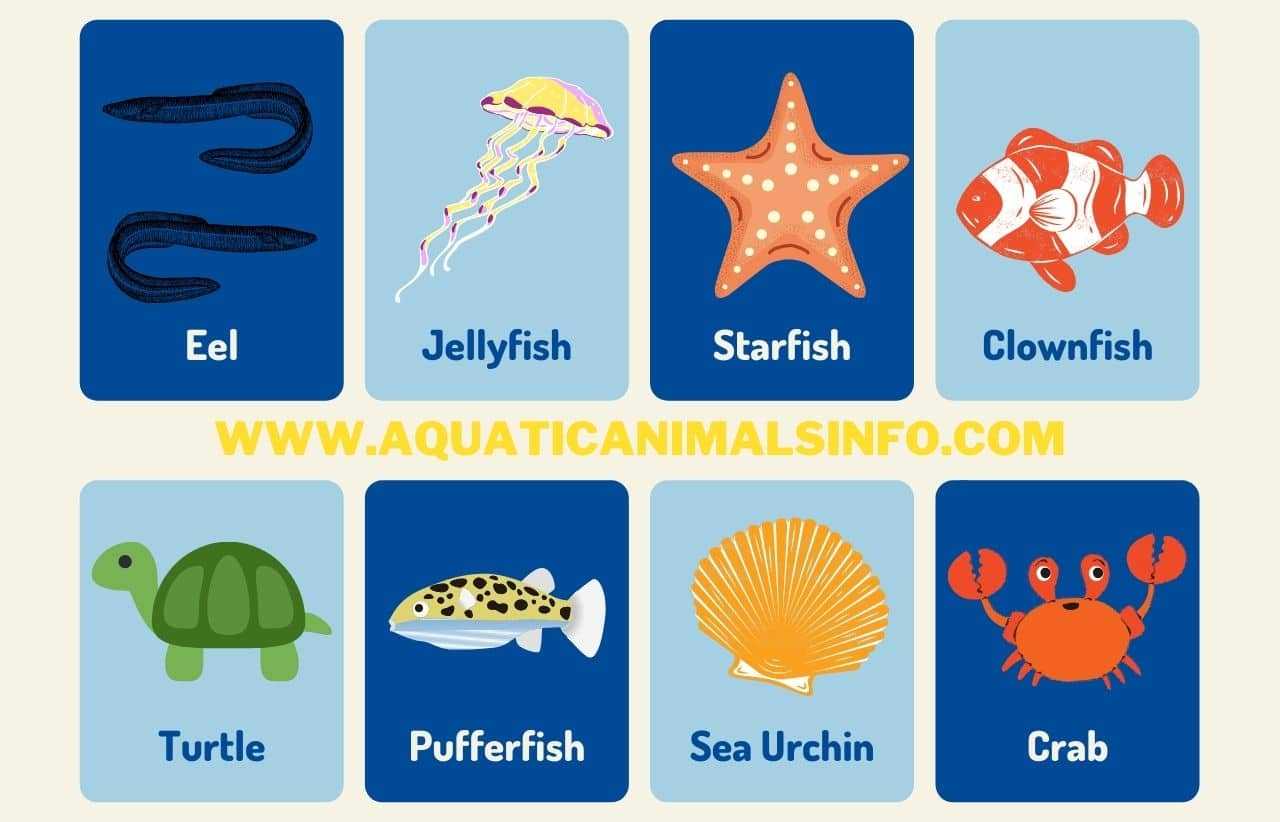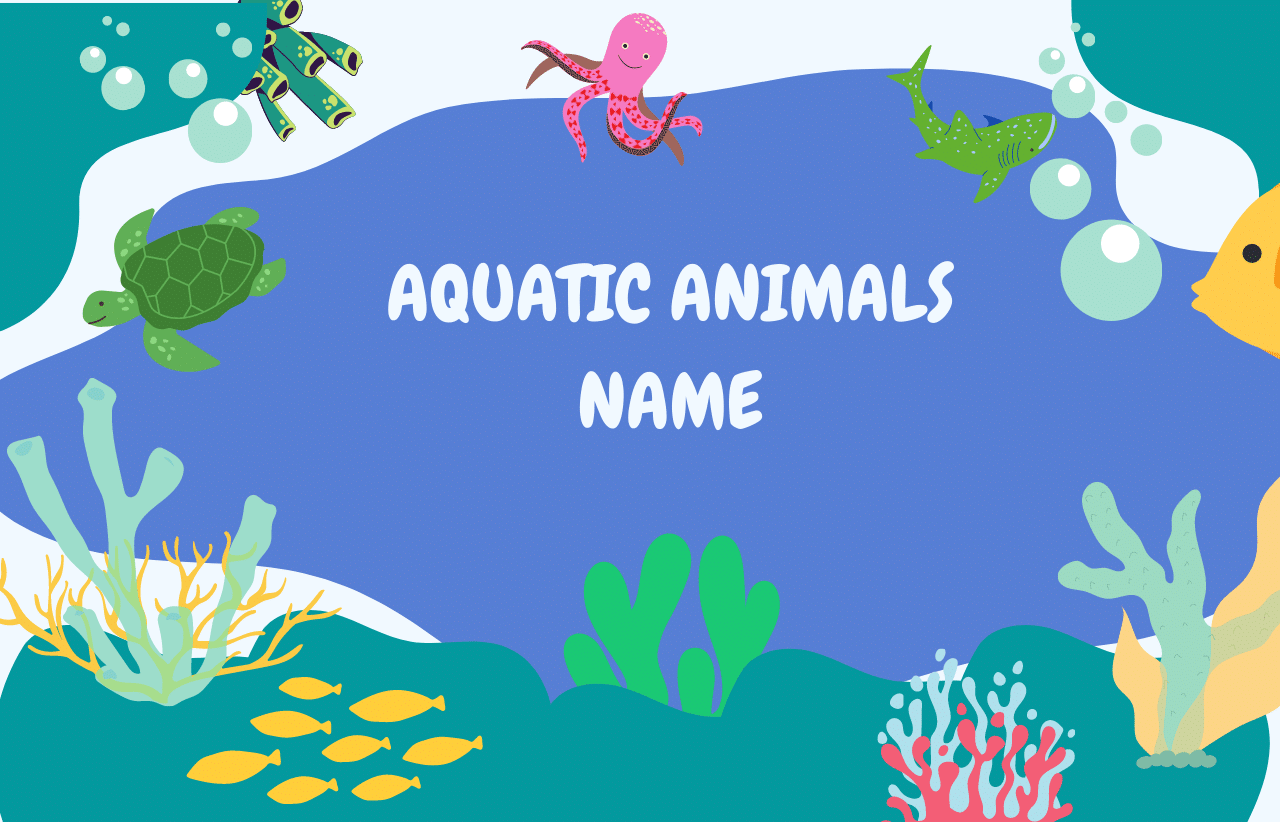Aquatic animals: Almost 80% of the planet Earth is an aquatic region, which serves as the habitat of millions of aquatic animal species. This variety of aquatic creatures is enough to give us a feeling about how tiny particles we are in this world.
It doesn’t matter how much know about aquatic biodiversity, each time we go into the sea or ocean, the aquatic ecosystem always has something to surprise us. That is because we have extremely limited information about aquatic life and people are very curious about it too.
That is why I have come up with well-researched and detailed information on aquatic creatures. Through this article, we’ll dive into aquatic life and get aware of their Habitat, Adaptations, Food, and also their life-threatening issues such as animal abuse, and so on.
Contents
What are aquatic animals?
The animals which spend their whole life or most of their life in water are called aquatic animals. The term itself means water. They can live both in water or land, that’s why they are classified into two types i.e., semi-aquatic and pure-aquatic.
As they can live in both water and land, breathing in these animals also varies as per their habitat. They have the ability to breathe air as well as extract dissolved oxygen from water. If they are on land, they simply breathe air and if they’re in the water, they extract dissolved oxygen through Gills (A specialized organ that helps to breathe in water).
Also Read: Animals That Start With N
Note: Keep one thing in mind Semi-aquatic and Amphibians are different. They are not the same, might possess the same property but differ in characteristics. By the way, we’ll talk about it later in this article.
Types of Aquatic Animals
According to the habitat, the aquatic creatures are categorized into two:
1. Pure aquatic
Pure aquatic are those that spend their whole life in water. They are also called Water animals as they cannot survive on land, for example, Fish. these animals are further categorized into two groups, Marine aquatic and Freshwater aquatic.
Also Read: Popular Animals That Start With M
The organisms that can survive their existence in Salt Water come under the Marine group and rest in the Freshwater group. Marine animals live in the ocean or sea, basically in salty water and Freshwater animals are habitat to rivers, lakes, ponds, etc.
The most interesting fact about these two marine and freshwater groups is that they can’t survive a second in their opponent environment like Marine water animals die in fresh water and Freshwater animals also die in saltwater.
Marine animals, if placed in freshwater, their body will start swelling up due to osmosis because water entering their body will fail to regulate properly which leads to death. The same happens with freshwater animals as well.
The main reason behind this phenomenon is that they both are evolved as per their habitat and can’t survive against their habitation.
2. Semi-aquatic
All aquatic animals live in water, but some have the ability to breathe in the air, those animals are called semi-aquatic creatures. They are almost similar to amphibians but, considering semi-aquatic creatures as an amphibian group is totally wrong. Although they look similar in characteristics, to some extent, they’re different.
Also Read: Sem-aquatic animal Names
Semi-aquatic vs Amphibians
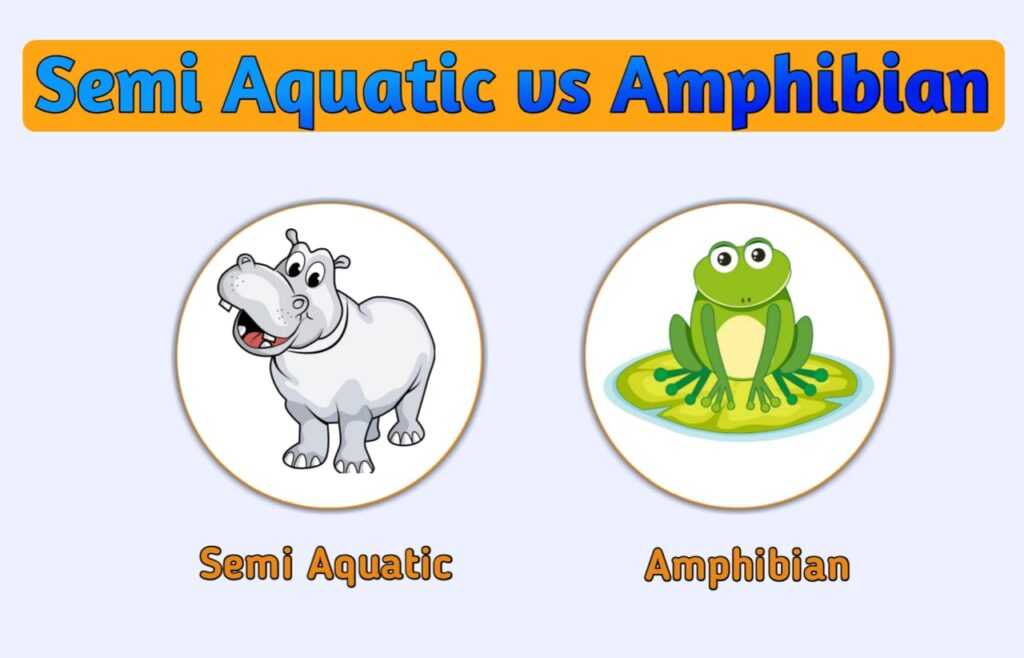
Both semi-aquatic and amphibians possess similar characteristics and habitats, but still, they are different. The following table will give a brief idea about the differences between them.
| Semi Aquatic | Amphibians |
|---|---|
| They spend the initial part of life on land | They spend the initial part of life in water and end part on land |
| Their habitat includes Freshwater as well as marine water | Their habitat includes freshwater only |
| They breathe by lungs | They breathe by skin and lungs |
| Example: Bear, Crocodile | Examples: Frogs. toads |
Characteristics of Aquatic Creatures
The following are the characteristics of aquatic or water animals:
- They can either be vertebrate or invertebrate
- They can live in both Saltwater and Freshwater and also on land
- They have Fins which helps in swimming
- Their body is streamlined and skin is scaled and smooth
Also Read: List of Animals That Start With X
These are the features or characteristics of marine animals. However, this is a general characteristic, some of the aquatic species have adapted various features or we can say capabilities.
Reproduction in Aquatic Creatures
The reproduction in these animals is the same as others i.e., through male and female gametes. The reproduction takes place by spawning.
Spawn is a gamete that carries reproductive cells such as eggs and sperm released into the water. The spawn of water animals consists of ova which is an unfertilized egg released by females into the water and males simultaneously release spermatozoa that fertilized the eggs. After the fertilization period, the offspring develops.
Almost all marine animals and amphibians reproduce through spawning except aquatic mammals and reptiles. Since spawning is sexual reproduction and sexual reproduction possesses variation, spawning too possesses variation which depends on sexual differences.
Habitat of Aquatic Creatures
The habitat of aquatic creatures is categorized into two groups- Freshwater animals and Marine aquatic, also known as seawater animals.
These two are evolved in such a way that they cannot survive against their habitat group. Marine grouped animals die in freshwater and the same case for freshwater animals as well.
Also Read: Wonderful Animals That Start With S
Marine Habitat: Marine water animals can survive in more than one percent of salt concentration in water. That’s why they are found in salty water sources such as Oceans, Seas, and Coral reefs.
Freshwater Habitat: For freshwater animals, the situation can be fatal if the salt concentration exceeds more than one percent. They are mostly found in rivers, lakes, ponds, streams, etc.
There is one more habitat that exists in a mixture of saline water and fresh water. These habitats include salt marshes, mangroves.
Adaptation of Aquatic Creatures
The modification of body structure and functions as per the habitat is called adaptation. Living organisms have the ability to adapt to their habitat. The aquatic creatures have adapted to the habitat by modifying their body structure and function.
1. Structural Adaptation
The body is stream-limed, which helps to reduce that water resistance and provides ease in floating in the water.
2. Breathing Adaptation
Gills is a specialized breathing organ that extracts dissolved oxygen from water that is further used by the body to function properly. Like most living organisms, water animals also take oxygen and exhale carbon dioxide.
Also Read: Cute Pet Animals Names
There are some sea animals like Whales and Dolphins that don’t have gills to respire. They have a blowhole located on their head. It can be called nostrils as well because the functioning of the human nose and blowhole is the same.
3. Movement Adaptation
The sea animals have a locomotory organ called Fins which helps to swim in the water. There are various types of fins such as dorsal fin, ventral fin, caudal and pelvic fins. The various types of Fins have different functions which all together, help the fish or other water animals to swim properly.
Functions of Fins in Water animals
Dorsal Fins: The Dorsal fin stabilizes the animals from rolling and helps in sudden turns. However, some species of water animals have adapted the dorsal fins for some other uses such as Sunfish, which uses its dorsal fin for propulsion.
Ventral and Pelvic Fins: The paired Pelvic and ventral fins are located below and behind pectoral fins but that differ from species to species. The pelvic fins assist the fish while going up and down into the water.
Also Read: 300+ Animals That Start With N
Caudal Fins: The Caudal Fin is also known as the tail fin, located on the end of the caudal peduncle. It is used to help in propulsion.
Pectoral Fins: The pectoral fins exist in pairs, located on each side. These fins create dynamic lifting force which assists the fish to maintain depth. It also helps in flying functions.
Anal Fins: The anal fins are located on the ventral part and are used to stabilize the fish while swimming.
Food of Aquatic Creatures
Just like terrestrial animals, the aquatic animal’s types also include herbivores, carnivores, and omnivores. The animals of the herbivores group eat seaweeds and phytoplankton. Phytoplankton is an aquatic plant that prepares food through photosynthesis.
The carnivores eat other animals and omnivores eat both seaweeds and other water animals. In short, Zooplankton and other small animals eat phytoplankton while animals like Krill eat zooplankton. The bigger animals eat krill and so on
Food Chain of Marine animals
The food chain of aquatic creatures also follows the basic food chain patterns like Producer on top, then Primary consumers, Secondary Consumers, Tertiary Consumers, and Top Predators at the bottom.
1. Producers
Producers play a crucial role in the aquatic food chain. They are basically plants that use sunlight to prepare their food. This mostly includes Seaweeds, Seagrass and Phytoplankton.
2. Primary Consumers
The primary consumers include herbivores water animals. Zooplankton is herbivores organisms that consume phytoplankton. They’re literally bigger than phytoplankton.
3. Secondary Consumers
The secondary consumers are carnivores. This includes Shrimps, Herring, Sardines and other small fishes.
Also Read: Animals That Start With X
4. Tertiary Consumer
The tertiary consumers include large marine animals that hunt secondary consumers. This includes large fishes such as Tuna and Codfish. The fishes of this category can grow up to 9 feet.
5. Top Predators
These animals are on the top of the food chain of marine animals. They hunt all consumers. This includes Sharks, Whales, and other large water animals. Their size can grow up to 15 to 16 feet.
Death of Aquatic Creatures
The life span of most aquatic creatures falls between 50 to 500 years. Water animals can live a really long life. However, this depends on the various factors but in general, an aquatic animal can swim for many years.
Examples of Some longest living water animals:
| Aquatic or Water Animals | Life in Years (Maximum) |
|---|---|
| Rougheye Rockfish | 205 |
| Bowhead Whales | 211 |
| Greenland Sharks | 272 to 512 |
| Giant barrel Sponge | 2300 |
| The Red Sea Urchin 200 | 200 |
Almost 90% of aquatic creatures failed to complete their original life cycle. They die at young. All these happen due to water pollution, particularly Plastic Wastes. Plastic is the biggest cause of the early death of water animals.
- Almost 100 million water animals lost their lives each year because of plastic waste
- 1 Lakh sea animals die from getting caught in plastic each year
- One 3rd of aquatic creatures found entangled in plastics
Also Read: Animals A to Z
Plastic is not just a single ocean pollution type out of many which cause death to most aquatic creatures. There are some other marine pollution types that cause great harm to aquatic life.
Marine Pollution causing Death of Water Animals:
1. Ocean Acidification
The oceans act as sponges for carbon dioxide, atmospheric carbon dioxide gets absorbed by the oceans, this absorbed CO2 impacts the pH level of marine water which changes the whole aquatic ecosystem.
2. Eutrophication
The increase in the chemical nutrient concentration of marine water is known as eutrophication. This affects aquatic life and causes a reduction in oxygen in the water. The Dead Zone gets created due to eutrophication.
There are some other water pollution types that contribute to aquatic pollution such as Toxins, Noise Pollution, etc.
List of Aquatic Animals
The following is a list of examples of marine animals:
- Clam
- Seagull
- Coral
- Pelican
- Shrimp
- Sea Cucumber
- Jellyfish
- Sea urchin
- Walrus Lobster
- Sea horse
- Squid
- Crab
- Shark
- Otter
- Seagull
- Octopus
- Clams
- Oyster
- Shells
- Dolphin
- Starfish
- Sea turtle
- Sea-lion
- Whales
- Electric Eel
- Penguin
- Cormorant
- Seal
- Clams
- Lobster
Cute Aquatic Animals
The aquatic life is blessed with such amazing creatures that make you’ll fall in love with them at first glance. There are cute animals that look so colorful and pretty. However, some are sold for aquariums but most are banned for aquariums.
1. Christmas tree worms
The Christmas tree worm looks bright in colors. Their average height is 1.5 inches in length. They are found deep in the ocean and get spotted easily because of their unique shape and colors.
2. Emperor shrimp
Emperor shrimp is a family of shrimp. They are one of the smallest creatures found in oceans. Their average height ranges between 0.16 inches to 0.30 inches.
3. Sea sponges
Sea sponges belong to members of the phylum Porifera. They are two-layer thin cells.
4. Bluebell tunicate
Bluebell tunicate belongs to the subphylum Tunicate family. They are invertebrates with thin and translucent.
5. Coffinfish
The Coffinfish is species of Sea toads. They are found in depth between 50 to 300 meters. Their body size can grow up to 8.7 inches.
6. Crimpson jellyfish
They look exactly like jellyfish, belonging to a species of small and immortal jellyfish.
7. Lined chiton
Lined chiton is a colorful aquatic animal with purple or black straight zigzag lines. They can grow up to a length of 5 cm.
8. Orange spotted filefish
Orange spotted filefish are generally found on coral reefs in the Indo-Pacific oceans. They are pale blue in color with longitudinal rows of orange-yellow patches.
9. Starfish
Starfish is a star-shaped fish belonging to the Asteroidean class. They’re invertebrates and found on sea beds. They’re found in various colors and patterns such as Red, Orange, Yellow, etc.
10. Scorpion fish
Scorpionfish known as rockfish found on sea beds. They are without venom but their fin spine can cause painful wounds.
11. Blue-ringed octopus
The blue-ringed octopus is a highly venomous species of octopus. Their venom is neurotoxins and they have rings of blue color in their arms.
12. Blue tang
Blue Tang is a member of the genus paracanthurus. They have a blue body with a black palette design and yellow colored tail.
13. Coral (Brain)
The coral brain looks like a human brain. Its shape is spherical and grooved. Generally, it grows up to 1.8 meters.
14. Flower hat jellyfish
Flower hat jelly belongs to class Hydrozoa. They rest on the bottom during the day and float at night to find their prey.
| Web Stories of Cute animals |
| Cute Fish |
| Cute Mammals |
| Cute Pet Animals in World |
| Cute Semi Aquatic Animal |
Weird Aquatic Animals
All types of animals exist in water. There are lots of weird sea animals that not only look weird but also behave weirdly. The following is the list of Top 15 Weird marine animals that look out of this world.
- Goblin Shark
- Black Swallower
- Frilled Shark
- The Paper Nautilus
- Giant Squid
- Vampire Squid
- Wolf Eel
- Pacific Black Dragon
- Dragon Fish
- Sarcastic Fringehead
- Big red Jellyfish
- Barreleye Fish
- Blobfish
- Supergiant Amphipod
- Giant Isopod
- Deep-Sea Lizardfish
Endangered Aquatic Animals
The aquatic life is filled with millions of species of creatures but due to pollution, some animals have been fall into endangered categories. The following table has some Endangered Animals that need to be saved otherwise it won’t take much time to extinct their species.
- Hawaiian Monk Seal
- Humpback Whale
- Crinoid Snapping Shrimp
- Napoleon Wrasse
- Kemp Ridley Turtle
- Fraser Dolphin
- Sockeye Salmon
- Steller Sealion
Facts About Aquatic Creatures
1. Dolphins sleep with one eye open.
2. Dolphins can hear sounds from 24KM of distance.
3. A blue whale’s tongue is heavier than an adult elephant’s.
4. Shark teeth can grow till their entire life.
5. The Octopus which is one of the famous sea animals is widely popular for its bulbous head and eight arms. They have blue blood and their hearts.
6. The sea sponge is a living aquatic creature yet it has no mouth, eyes, bones, lungs, brain, or even hearts
7. Jellyfish have lived for more than 650 million years, outdating dinosaurs and sharks
8. A single electric eel is known to generate enough electricity to light up to 10 bulbs
Also Read: Facts about semi-aquatic animal
9. Sea otters have a secret pocket of skin near their armpit to store blood
10. Male penguins propose to their lady with pebble during mating season
11. Sea horsees are among the only species in which the male gives birth and takes care of the young.
12. Clownfish and Anemones are best friends
13. Scorpionfish’s egg takes only two days to hatch
14. Frogfish can walk
15. Eating Pufferfish can kill you
16. Crabs have tastebuds on their feet.
17. Crab’s teeth are in the stomach.
18. Lobsters can re-grow an eye or an arm.
19. Sea turtles excrete salt absorbed in seawater from their eyes, which is why they seem to cry.
19. Many Rockfish can live 100s of years.
20. A female Sunfish may lay 300,000,000 eggs at a single spawning season.
FAQ
The following are the Frequently Asked Questions about Aquatic or Water Animals:
What is an Aquatic Animal example?
The examples of aquatic creatures are Clam, Coral, Cormorant, Crab, Dolphin, Electric Eel, etc
What are the characteristics of Aquatic Animals?
The characteristics of water animals include Fins, Gills, Blowhole, Scaled Body, etc.
How do Aquatic Animals breathe?
As aquatic creatures can also live outside water, they can breathe air as well as dissolve oxygen from the water through Gills. Semi-aquatic breathe air from the atmosphere and pure-aquatic extracts oxygen from water.
Why do Aquatic Animals breathe faster than terrestrial animals?
The concentration of oxygen in water is comparatively less than in air. The air has almost 21% of oxygen but in water, the concentration falls down to only 1% and this causes these animals to breathe faster than terrestrial animals.
What are the examples of aquatic habitats?
The habitat of Aquatic creatures includes both water and land. But many are connected to the land, most live in water such as Oceans, Seas, Lakes, Streams, Ponds, etc.
Which is aquatic animal name?
The animal that spends their whole life or most of their life in water are called aquatic animal.
What are the 10 water animals?
10 Water animals names are 1. Crab, 2. Seal, 3. Octopus, 4. Shark, 5. Seahorse, 6. Walrus, 7. Starfish, 8. Penguin, 9. Jellyfish, 10. Squid
Conclusion
The aquatic animal plays an important role in the living ecosystem. They are an essential part of living life. So try to decrease quantic pollution and especially Plastic waste. Most of the people throw plastic bottles and all while roaming on the beach which gets dragged into the ocean with tides.
I know it won’t affect much ocean pollution because industries are most responsible for that but still, your one step will definitely make a difference.
Meanings of some animal-related terms used in this article:
This article has some biological terms, check the meanings for better understanding. Some meanings have been taken from Google, so the Credit for these meanings goes to Google.com
Gills: A specialized organ that extracts oxygen from the water surface
Vertebrate: An animal of a large group distinguished by the possession of a backbone or spinal column, including mammals, birds, reptiles, amphibians, and fish.
Invertebrate: An animal lacking a backbone, such as an arthropod, mollusk, annelid, coelenterate, etc. The invertebrates constitute an artificial division of the animal kingdom, comprising 95 percent of animal species and about thirty different phyla
Aquatic: Related to water
Marine: Related to salty water
Habitat: The natural home or environment of an animal, plant, or other organisms
Adapt: Make (something) suitable for a new use or purpose
Spawn: Release or deposit eggs
Carnivores: The one who eats flesh
Herbivores: The one who eats plants
Omnivores: The one who eats both Flesh and Plants
Reference: Wikipedia, Britannica, Sciencedirect
So that’s all about Aquatic animals and their lifestyle. I hope you’ve understood everything about them because we have discussed almost everything about their life, whether it is their Habitat, Adaptations, Reproduction, Death Causes, Food and Food Chain, everything is covered in detail. In order to have some further extra knowledge about them, you can follow this aquaticanimalsinfo.com

